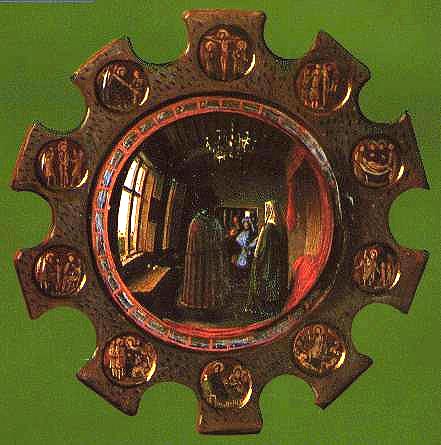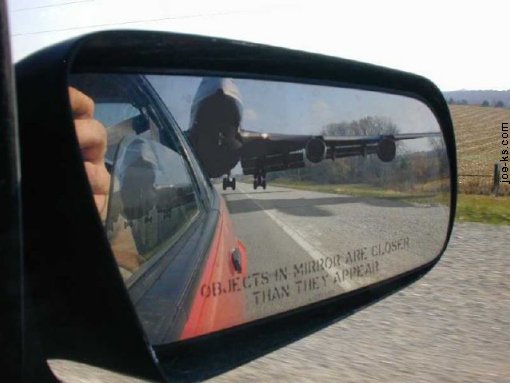
 |
Closer Than That? |
How about a science puzzler for you? Every car has mirrors on the side, for the use of the driver, and these mirrors all display a label, “Objects in Mirror are Closer than they Appear!” But in fact, if you move your head around while looking into such a mirror, you will discover that the image of the object seen in the mirror appears to be located just “inside” the surface of the mirror, in fact just inches away. That is, an object 50 feet away appears in reflection to be right at the mirror surface!
So, what kind of mirror is it and how does it work, and why does the label say precisely the opposite of what is true? First, if you want to see a larger example of such a mirror, go to any nearby convenience store and look in the corners!
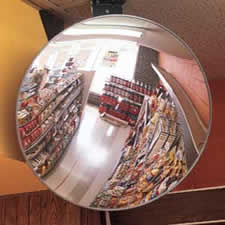 |
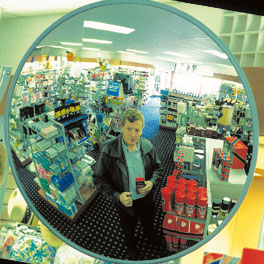 |
|
What you are looking at in all
such cases, on your
car or in the store, is a convex or diverging mirror. Such a mirror
always produces
a virtual image (like a flat mirror), but unlike the flat mirror, it
produces an image
greatly reduced in size. It thus shows a much wider field of view than
a flat
mirror would. In a flat mirror, the image appears just as far past the
mirror surface
as the object is on the other side, and is the same size as the object.
But in the convex mirror, the image
appears very
close to the mirror surface, and is much smaller in size than the
object. In cars sold in North America, the mirror on the driver's left,
and the centrally-located rear-view mirror, are flat. The mirror
on the passenger's right is a convex mirror, bearing the
mysterious inscription. |
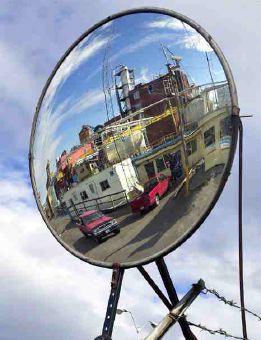 |
So, indeed, as we said, the mirror on every automobile in the US shows objects behind the car to be much closer to the car than they actually are, often by factors of 10 to 100. So why then does the mirror have a label on it that says the “objects are closer than they appear,” when in fact the objects appear to be only inches away but are actually many feet away? So is this just another (but nearly universal) entry in the completely crazy warning labels contest? Want to see some more?
To understand the label on the right-hand auto mirror, as well as the labels on steam irons that say, “Warning, this product may become hot,” or the labels on potato chip bags that say “Do not eat bag; only contents of bag are edible,” it is necessary to visualize the fact that every large corporation has a million-dollar-per-year lawyer with an IQ of about 90. His job is to picture the behavior of that substantial fraction of consumers that have an IQ even lower than his own. What will such a consumer do if presented with a cardboard sheet that covers a parked car's windshield to prevent sunlight from entering the car from the front? Place the sheet over the windshield, of course. But then “forget” to remove the sheet when getting into the car and driving off, even though it is impossible to see through the windshield with the cardboard in place... and then to sue the manufacturer of the cardboard after the inevitable accident? These are not hypothetical cases, they happen daily. This is why those cardboard sheets bear in large letters the notice, “Remove Before Operating Vehicle!”
But why do the mirrors say exactly the opposite of the true situation? Again, put yourself in the place of the corporate lawyer. He knows, if you do not, that “against stupidity, the gods themselves contend in vain.” Picture what a complete moron would say if he wanted to blame the wide-angle mirror for his latest accident— ”I didn't know that there car wuz so closet to me, it wuz just a li'l thing in that there mirror, didn't look near at all!” So the notice must cover the possibility that a complete moron, even with two eyes and depth perception, judges the distance to that oncoming huge tractor-trailer truck by the size of the image in a wide-angle mirror!
There's way too much duplication in Internet lists of goofy warning labels, but here are a few more: Wacky Labels, more Wacky Labels.
